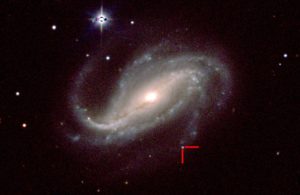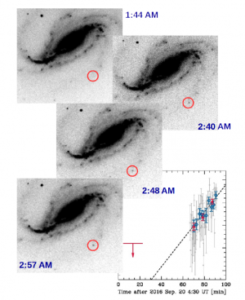Keck Observatory Studied Amateur Photo that ‘Won Cosmic Lottery’

Supernova 2016gkg in spiral galaxy NGC 613; color image taken by a group of UC Santa Cruz astronomers on Feb. 18, 2017, with the 1-meter Swope telescope. CREDIT: CARNEGIE INSTITUTION FOR SCIENCE, LAS CAMPANAS OBSERVATORY, CHILE.
Victor Buso of Argentina was testing a new camera through his 16-inch telescope on Sept. 20, 2016, when he struck the equivalent of the “cosmic lottery.” After capturing a series of short-exposure photos of the spiral galaxy NGC 613, the amateur astronomer noticed a faint point of light emerging in the series at the outer arms of the galaxy some 80 million light years from Earth.
As it turns out, Buso had serendipitously captured the rare first light that emerges when a star explodes, creating a supernova. Astronomers say capturing an image like this is like winning the cosmic lottery— the chances are estimated at one in 10 million, or perhaps even one in 100 million.
Hawai‘i Island’s W.M. Keck Observatory was among the global institutions that conducted analysis of Buso’s images and follow-up observations. The images are providing scientists with important clues into the nature of supernovae and the physical composition of stars fated to explode.

CREDIT: V. BUSO, M. BERSTEN, ET AL. Sequence of combined images (negatives, so black corresponds to bright) obtained by Víctor Buso as SN 2016gkg appears and brightens in the outskirts of the spiral galaxy NGC 613. Labels indicate the time each image was taken. The object steadily brightens for about 25 minutes, as shown quantitatively in the lower-right panel.
“Professional astronomers have long been searching for such an event,” said UC Berkeley astronomer Alex Filippenko, who followed up the discovery with observations at the Lick and Keck observatories that provided a detailed analysis of the explosion, called SN 2016gkg. “Observations of stars in the first moments they begin exploding provide information that cannot be directly obtained in any other way.”
Researchers at Keck Observatory on Maunakea conducted follow-up observations using the Low Resolution Imaging Spectrometer (LRIS) and the DEep Imaging and Multi-Object Spectrograph (DEIMOS) to gather further data on the supernova event.
The chance discovery and accompanying analysis will be published in the Feb. 22 issue of the journal Nature.














